Construction Equipment
Bearings are pivotal in construction machinery, serving as essential components that facilitate smooth and efficient operation. Construction equipment relies on robust and reliable components to withstand the demanding environments it operates in. Quality bearings are one crucial element in ensuring the smooth functioning of construction machinery.
These precision-engineered elements reduce friction, support heavy loads, and enable rotational motion in various moving parts of construction equipment.Loyal, a renowned manufacturer in the industry, specializes in providing high-performance bearings specifically designed for construction equipment.
Loyal’s construction equipment bearings stand out for their durability, precision engineering, customization options, compatibility, reliability, and trustworthiness, making them indispensable components for ensuring the optimal performance of construction machinery.
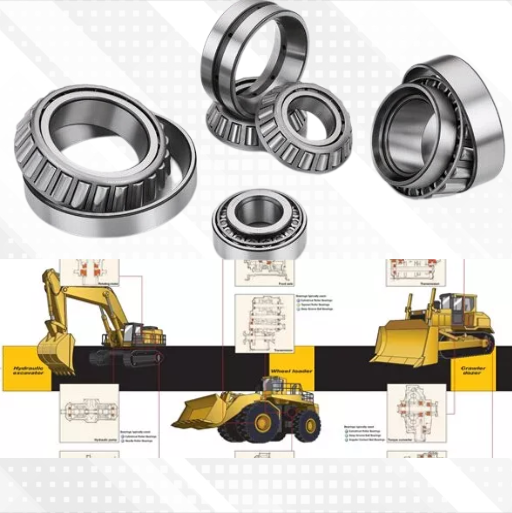
Overview of Construction Equipment Bearings
In the realm of construction machinery, bearings play a crucial role in enabling smooth operation and reducing friction between moving parts. Understanding the diverse types of bearings utilized in construction equipment is essential for optimal performance and maintenance. Let’s delve into the classification of bearing types commonly found in heavy machinery:
Classification of Bearing Types
Ball Bearings:
| Function | Enable smooth, low-friction rotational motion by rolling within races. |
| Uses | Commonly found in excavators, bulldozers, wheels, gears, and shafts. |
Cylindrical Bearings:
| Function | Handle radial loads effectively by distributing the load along cylindrical rollers. |
| Uses | Found in cranes to support crane hooks and lift heavy loads. |
Tapered Roller Bearings:
| Function | Designed with conical rollers to handle both radial and axial loads efficiently. |
| Uses | Common in wheel assemblies of construction vehicles like dump trucks and loaders. |
Slew Bearings:
| Function | Enable 360-degree rotation in machines like cranes, excavators, and wind turbines. |
| Uses | Essential for heavy machinery requiring continuous full-circle rotation. |
Needle Bearings:
| Function | Utilize long, thin cylinders (needles) to carry high loads in a compact design. |
| Uses | Suitable for heavy machinery with compact designs like skid steers. |
Joint Bearings:
| Function | Accommodate oscillating, tilting, and rotating movements in equipment components. |
| Uses | Found in articulated dump trucks and backhoes for flexible multi-directional movement. |
By grasping the nuances of construction equipment bearings and their varied types, equipment operators can make informed decisions to uphold the reliability and functionality of their machinery.
When installing construction equipment bearings, it’s essential to consider several key factors to ensure a successful and efficient installation process. Here are the important points to note:
Things to note when installing
Careful Handling:
Proper handling of bearings is crucial during installation to avoid any damage that could affect their performance. Ensuring a clean work environment and using appropriate tools can help prevent contamination and maintain the integrity of the bearings.
Lubrication:
Effective lubrication is vital for reducing friction and extending the service life of the bearings. Using the correct lubricant in the right amount at the right intervals can significantly enhance the operational efficiency of the construction equipment.
Alignment and Fitting:
Precise alignment and fitting of bearings as per the manufacturer’s specifications are essential for optimal performance. Incorrect alignment can lead to premature wear and operational issues, emphasizing the importance of meticulous installation.
Torque Control:
Applying the right amount of torque during the installation process is critical to prevent overloading and ensure the bearings function correctly. Following recommended torque values helps maintain the bearings’ longevity and reliability.
Post-Installation Inspection:
Conducting a thorough inspection after installation is crucial to identify any potential issues early on. Regular post-installation checks can help detect abnormalities, allowing for timely adjustments and maintenance to uphold the bearings’ function.
Problems that may occur during use of Construction Equipment Bearings
Construction equipment bearings are subjected to harsh operating conditions and heavy loads, leading to potential issues that can impact performance. Here are some common problems that may occur during the use of construction equipment bearings:
Overheating: Excessive heat generation due to friction or inadequate lubrication can lead to bearing overheating, causing premature wear and potential failure.
Excessive Noise: Abnormal noise during operation can indicate misalignment, contamination, or bearing damage, necessitating immediate attention to prevent further issues.
Vibration: Excessive vibration may result from misalignment, improper installation, or bearing wear, indicating a need for inspection and corrective measures.
Premature Wear: Insufficient lubrication, contamination, or overloading can accelerate wear on bearing surfaces, reducing operational lifespan.
Corrosion: Exposure to moisture or harsh environments can lead to bearing component corrosion, compromising performance and durability.
Misalignment: Improper alignment of bearings can cause uneven loading, increased friction, and accelerated wear, impacting overall equipment performance.
Fatigue Failure: Continuous cyclical loading can lead to fatigue failure in bearings over time, necessitating proper maintenance and monitoring.
Seal Damage: Ineffective sealing can allow contaminants to enter the bearing, leading to damage, reduced efficiency, and potential failure.
Improper Lubrication: Incorrect lubricant type or quantity can result in inadequate protection against friction and wear, affecting bearing performance.
Load Limit Exceedance: Operating bearings beyond their specified load capacities can lead to premature failure and compromised equipment safety.
Addressing these potential problems proactively through regular maintenance, proper installation, suitable lubrication practices, and adherence to operational guidelines can help mitigate risks and ensure the reliable performance of construction equipment bearings.
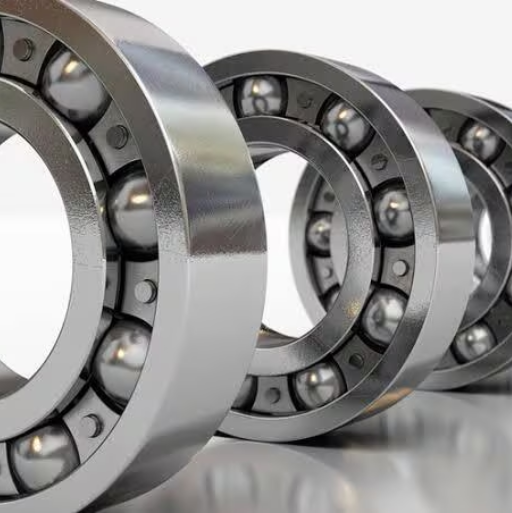
Product Clearance Requirements for Construction Equipment Bearings
Product clearance refers to the internal space within a bearing that allows for proper functioning, thermal expansion, and smooth operation. Understanding and adhering to specific clearance requirements is crucial for optimal performance and longevity in the context of construction equipment bearings. Here’s a detailed explanation of product clearance requirements:
Functionality: Adequate product clearance ensures that there is enough internal space within the bearing for the components to move freely without interference. This freedom of movement is essential for accommodating varying operating conditions and loads.
Thermal Expansion: Construction equipment operates in environments where temperatures can fluctuate significantly. Proper product clearance accounts for thermal expansion, allowing the bearing components to expand and contract without causing binding or undue stress on the bearing structure.
Avoiding Binding: Insufficient clearance can lead to binding, where the bearing components rub against each other under load or temperature changes. This can result in increased friction, heat generation, and premature wear, impacting the equipment’s overall efficiency.
Smooth Operation: The correct amount of clearance ensures smooth operation of the bearing, reducing friction and minimizing the risk of component damage. Smooth operation is essential for maintaining equipment performance and preventing operational disruptions.
Manufacturers’ Specifications: Bearing manufacturers provide guidelines on the recommended clearance values for different bearing types and applications. Adhering to these specifications is critical to ensure proper functioning and longevity of the bearings in construction equipment.
Misalignment Prevention: Proper clearance helps prevent misalignment issues, which can arise from inadequate space between bearing components. Misalignment can lead to uneven loading, increased stress on the bearing, and potential operational inefficiencies.
Load Distribution: Optimal product clearance facilitates even load distribution across the bearing components, preventing localized stress concentrations and promoting uniform wear, thus extending the bearing’s service life.
Maintenance Considerations: Product clearance should be regularly monitored during equipment maintenance checks to detect deviations or abnormalities that may affect bearing performance. Adjustments to clearance levels should be made as needed to maintain optimal operation.
By ensuring that construction equipment bearings meet the necessary product clearance requirements, operators can enhance the reliability, efficiency, and durability of their machinery, ultimately contributing to smoother operations and reduced maintenance needs.
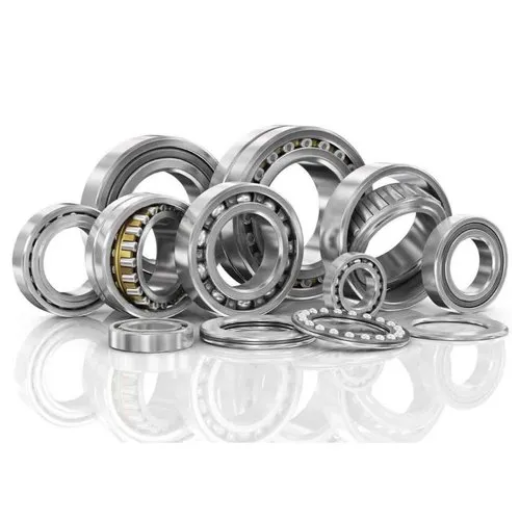
Product Sealing Requirements for Construction Equipment Bearings
Product sealing is a crucial aspect of construction equipment bearings to protect them from contaminants and ensure optimal performance and longevity. Here is a detailed explanation of product sealing requirements for construction equipment bearings:
Contaminant Protection: Sealing on construction equipment bearings acts as a barrier against contaminants such as dust, dirt, water, and debris that can compromise the internal components. Effective sealing prevents ingress of harmful particles that could lead to premature wear and reduced operational lifespan.
Environmental Protection: Construction sites often expose bearings to harsh environmental conditions, including moisture, chemicals, and abrasive materials. Proper sealing guards against these elements, maintaining the integrity of the bearing components and preventing corrosion or damage.
Lubricant Retention: Seals help retain lubricants within the bearing assembly, ensuring proper lubrication of moving parts. Adequate sealing prevents lubricant leakage, maintains the necessary film between surfaces, and reduces friction, contributing to smooth operation and extended bearing life.
Longevity and Reliability: Well-sealed construction equipment bearings experience less wear and operate more reliably over time. By keeping contaminants out and lubricants in, seals contribute to the longevity and consistent performance of the bearings, reducing the likelihood of unplanned downtime.
Different Types of Seals: Construction equipment bearings may utilize various types of seals, such as contact seals, non-contact seals, shielded bearings, or sealed bearings. The choice of seal depends on factors like operating conditions, contamination risks, and maintenance requirements, with each type offering specific benefits for protection and performance.
Maintenance Considerations: Seals must be regularly inspected during equipment servicing to check for wear, damage, or deterioration that could compromise their effectiveness. Timely replacement of worn seals helps maintain the protective barrier and ensure continued reliability of the bearings.
Application-Specific Sealing: Bearing seals can be tailored to specific applications within construction equipment, considering factors like load capacity, speed, temperature, and exposure risks. Customized sealing solutions optimize performance and safeguard bearings in diverse operating environments.
Seal Integrity Testing: Periodic testing of seal integrity using methods like pressure testing or visual inspections can confirm that the seals are functioning as intended. Identifying and addressing seal issues promptly enhances the overall protection and performance of construction equipment bearings.
By understanding and meeting the product sealing requirements for construction equipment bearings, operators can safeguard their machinery against external hazards, preserve internal lubrication, and uphold the equipment’s reliability and efficiency throughout its operational lifespan.
Usage environment requirements
In the context of Construction Equipment Bearings, Usage environment requirements refer to the necessary conditions for bearings used in construction equipment to operate effectively. These requirements typically include:
Dust and Debris Resistance: Considering the presence of dust and debris on construction sites, bearings need to have good dust and foreign particle resistance to ensure smooth operation.
Water and Moisture Protection: Given potential exposure to damp environments or water contact, bearings should have waterproof and moisture-resistant properties to prevent corrosion and damage.
Temperature and Weather Resistance: In outdoor construction work, bearings must withstand various temperatures and weather conditions to ensure operational reliability in harsh environments.
Vibration and Shock Absorption: Construction equipment is prone to vibration and impact, so bearings should offer good shock absorption and cushioning capabilities to protect the equipment and prolong its lifespan.
Load-Bearing Capacity: Due to the heavy loads construction equipment often carries, bearings need to have sufficient load-bearing capacity to ensure stable and reliable equipment operation.
Corrosion Resistance: If construction equipment is exposed to corrosive substances, bearings should possess corrosion-resistant properties to extend their lifespan and reduce maintenance costs.
These are some common considerations for usage environment requirements to ensure Construction Equipment Bearings operate effectively in construction equipment, maintaining stability and reliability.
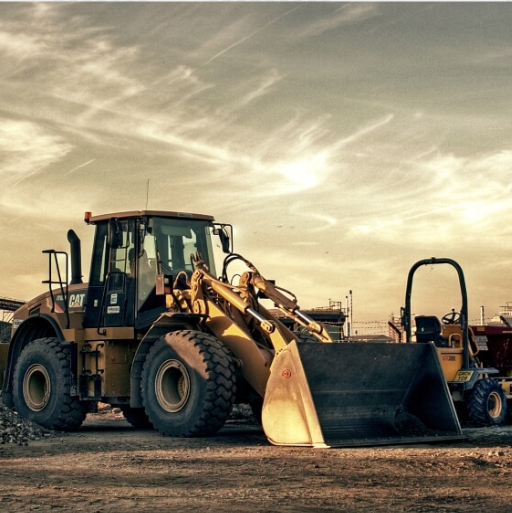 Lubricant selection
Lubricant selection
When it comes to lubricant selection for Construction Equipment Bearings, several factors need to be considered to ensure optimal performance and longevity of the bearings. Some key points to consider include:
Load and Speed Requirements: The lubricant chosen should be able to withstand the specific load and speed conditions of the construction equipment bearings to reduce friction and wear.
Temperature Range: Select a lubricant that can function effectively within the equipment’s temperature range to prevent the bearings from overheating or freezing.
Water and Contaminant Resistance: Opt for a lubricant that provides adequate protection against water ingress and contamination, especially in construction environments where these elements are prevalent.
Compatibility with Materials: Ensure the lubricant is compatible with the materials used in the bearings to prevent degradation or damage to the bearing components.
Longevity and Maintenance: Choose a lubricant that offers long-lasting lubrication properties to reduce the frequency of maintenance and reapplication, thus extending the lifespan of the bearings.
Environmental Impact: Consider using environmentally friendly lubricants that align with sustainability goals and regulations, especially in construction projects where eco-friendly practices are encouraged.
Selection Of Bearing Type
When it comes to the selection of bearing type for construction equipment, several important factors should be taken into consideration to ensure the bearings meet the specific requirements of the application. Here are key points to consider:
Load Capacity: Choose a bearing type that can effectively handle the anticipated loads generated by the construction equipment without premature wear or failure.
Speed Capability: Consider the rotational speed requirements of the equipment and select a bearing type that can operate efficiently at the required speeds.
Axial and Radial Loads: Determine the types of loads (axial, radial, or both) that the bearing will need to support and select a bearing type designed to handle these loads effectively.
Mounting and Installation: Consider the ease of mounting and installation of the bearing type within the construction equipment to ensure convenient maintenance practices.
Lubrication Requirements: Different bearing types may have varied lubrication needs, so choose a bearing type that aligns with the lubrication plan of the equipment for optimal performance.
Environmental Conditions: Take into account the operating environment of the construction equipment, including factors such as temperature, moisture, dust, and vibration, and select a bearing type that can withstand these conditions.
Maintenance Needs: Consider the maintenance requirements of different bearing types and choose one that aligns with the maintenance schedule and capabilities of the equipment operators.
By carefully evaluating these factors and selecting the most suitable bearing type for construction equipment, you can help ensure smooth operation, longevity, and reliability of the equipment in demanding construction environments.
Bearing Life
Bearing life refers to the duration for which a bearing is expected to operate under specific conditions before showing signs of wear or malfunction. Several factors can influence bearing life, and taking proactive measures can help extend the lifespan of bearings in construction equipment. Here are some key influencing factors and strategies to prolong bearing life:
Factors Influencing Bearing Life:
Load and Speed: Heavy loads and high speeds can accelerate wear and reduce bearing life. Ensure bearings are appropriately sized and rated for the loads and speeds encountered.
Lubrication: Inadequate or improper lubrication can lead to increased friction and premature wear. Use the correct lubricant type and amount as per manufacturer recommendations.
Contamination: Dust, debris, water, and other contaminants can compromise bearing performance. Implement proper sealing, shielding, and maintenance practices to prevent contamination.
Installation and Alignment: Incorrect installation, misalignment, or improper fits can introduce stress and reduce bearing life. Follow precise installation procedures and ensure proper alignment.
Temperature and Environment: Extreme temperatures, humidity, and corrosive environments can impact bearing performance. Choose bearings rated for the operating conditions and implement temperature control measures.
Vibration and Shock: Excessive vibrations and shocks can damage bearings. Consider vibration damping solutions and shock-absorbing mounts to mitigate these effects.
Maintenance Practices: Regular inspections, monitoring of bearing condition, and timely replacement of worn components can help prevent unexpected failures and prolong bearing life.
Strategies to Prolong Bearing Life:
Proper Installation: Ensure bearings are correctly installed, aligned, and mounted according to manufacturer guidelines to minimize stress and ensure even load distribution.
Regular Lubrication: Maintain a consistent lubrication schedule using the right lubricant type and quantity to reduce friction, dissipate heat, and protect against wear.
Seal Protection: Use effective sealing mechanisms to prevent contamination ingress and maintain lubricant integrity for prolonged bearing performance.
Monitoring and Maintenance: Implement routine inspections, vibration analysis, and temperature monitoring to detect early signs of wear or issues requiring attention.
Training and Education: Provide training to personnel on proper handling, maintenance procedures, and best practices for bearing care to ensure optimal performance and longevity.
By addressing these influencing factors and adopting proactive strategies to prolong bearing life, you can enhance the reliability, efficiency, and lifespan of bearings in construction equipment applications.
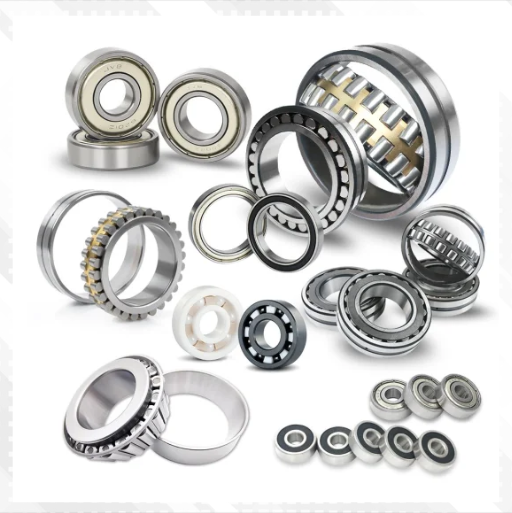
Basic Dynamic Load Rating (C) and Fatigue Life
Basic Dynamic Load Rating (C):
Definition: The Basic Dynamic Load Rating (C) of a bearing is the constant radial load in kilonewtons that a group of identical bearings can theoretically endure for a rating life of one million revolutions.
Significance: C is used to compare bearing load capacity across different sizes and types. It indicates the load a bearing can carry under dynamic conditions.
Calculation: Manufacturers provide C values in their catalogs based on testing and standards. It factors in material properties, design, and geometry of the bearing.
Fatigue Life:
Definition: Fatigue life refers to the number of revolutions or cycles that a bearing can endure before material fatigue leads to failure.
Factors: Factors influencing fatigue life include load magnitude, speed, lubrication, material properties, surface finish, and operating conditions.
Calculation: The calculation involves estimating the dynamic equivalent radial load (P), applying it to the bearing life formula, and considering factors like reliability, operating conditions, and maintenance practices.
Relationship Between C and Fatigue Life:
High C values indicate greater load-carrying capacity, potentially leading to longer fatigue life.
Properly selecting bearings with adequate C ratings relative to actual loads can help optimize fatigue life.
Balancing loads within the rated capacity and ensuring proper lubrication and maintenance can further extend bearing fatigue life.
Strategies to Enhance Fatigue Life:
Optimal Load Distribution: Ensure loads are evenly distributed among multiple bearings to prevent overloading.
Proper Lubrication: Maintain correct lubrication levels and quality to reduce friction and wear.
Operating Conditions: Monitor and control temperature, vibration, and contamination levels to minimize stress on bearings.
Regular Maintenance: Implement routine inspections, monitoring, and replacement of worn components to prevent premature failure.
Application-specific Considerations: Tailor bearing selection and maintenance practices to the unique demands of the construction equipment environment.
By understanding the Basic Dynamic Load Rating (C) and Fatigue Life concepts and implementing strategies to optimize bearing performance and longevity, you can enhance the reliability and efficiency of bearings in construction equipment applications.
Dynamic Equivalent Load
Definition:
Dynamic Equivalent Load (P) is a theoretical load that, if applied to the bearing, would result in the same calculated basic dynamic load rating (C) as the actual combined load and its direction.
It is used to simplify complex loads into a single equivalent load for bearing life calculations.
Calculation:
Radial Loads: For radial loads, the formula to calculate the Dynamic Equivalent Load is P = XFr + YFa, where Fr is the radial load, Fa is the axial load, and X and Y are the factors depending on the bearing type and internal geometry.
Axial Loads: For axial loads, the calculation considers only the axial load component: P = Fa.
Significance:
By converting combined radial and axial loads into a single equivalent load, engineers can assess the bearing’s performance under varying load conditions.
The Dynamic Equivalent Load helps simplify calculations for bearing selection, fatigue life estimation, and performance analysis.
Application:
The Dynamic Equivalent Load is crucial in determining the actual load impact on bearings, considering both radial and axial components.
It aids in predicting bearing behavior under different operational conditions and load scenarios, allowing for more accurate design and maintenance decisions.
Factors Affecting Dynamic Equivalent Load:
Load Magnitude: Higher loads lead to increased Dynamic Equivalent Load, impacting bearing performance and longevity.
Load Direction: Varied load directions require consideration of both radial and axial components for accurate load calculations.
Bearing Type: Different bearing types have specific factors (X and Y) that influence the conversion of loads into the equivalent dynamic load.
Importance for Construction Equipment Bearings:
In construction equipment applications, where bearings experience diverse and fluctuating loads, understanding the Dynamic Equivalent Load is essential for optimizing bearing selection, performance, and reliability.
Properly calculating and considering the Dynamic Equivalent Load ensures that bearings are adequately sized and rated to withstand the operational demands of construction equipment.
By grasping the concept of Dynamic Equivalent Load and its calculation methods, engineers and maintenance personnel can make informed decisions regarding bearing selection, maintenance practices, and overall equipment reliability in construction applications.
Basic Static Load Ratings and Static Equivalent Loads
Basic Static Load Rating (C0):
Definition: The Basic Static Load Rating (C0) of a bearing is the maximum uniformly distributed load that can be applied to the non-rotating bearing without damage, assuming a stationary condition.
Significance: C0 represents the load capacity of a bearing when subjected to static forces or very slow rotations, providing an indication of the bearing’s ability to withstand loads without permanent deformation.
Static Equivalent Load (P0):
Definition: The Static Equivalent Load (P0) is an equivalent static load value that represents combined radial and axial loads acting on the bearing when subjected to static conditions.
Calculation: P0 is calculated based on the actual radial and axial loads applied to the bearing, considering factors like load direction, magnitude, and distribution.
Relationship Between C0 and P0:
C0 is the maximum static load a bearing can withstand without deformation, while P0 is the equivalent static load acting on the bearing under actual load conditions.
Properly matching the C0 rating with the actual static loads ensures the bearing can support the applied forces without experiencing permanent damage.
Significance of C0 and P0:
C0 and P0 values are essential for assessing the static load-carrying capacity of bearings and evaluating their performance in stationary or low-speed applications.
Understanding C0 and P0 helps in selecting suitable bearings for equipment subjected to static loads, ensuring reliable operation and longevity.
Factors Affecting C0 and P0:
Load Magnitude: Higher static loads increase the importance of having a sufficient C0 rating and accurately calculating the P0 value.
Load Distribution: Uneven or concentrated static loads may require adjustments in bearing selection to account for potential localized stresses.
Bearing Type: Different bearing designs and materials have varying C0 capacities and responses to static loads, influencing P0 calculations.
Application in Construction Equipment:
In construction equipment where static loads from equipment weight, structural forces, or stationary operations are prevalent, understanding C0 and P0 is crucial for selecting bearings that can withstand these forces.
Ensuring that bearings have adequate C0 ratings and considering the calculated P0 values help prevent premature failure and ensure the reliability of bearings in static load conditions.
By comprehending the concepts of Basic Static Load Ratings (C0), Static Equivalent Loads (P0), and their implications, engineers and maintenance professionals can make informed decisions regarding bearing selection, maintenance practices, and equipment performance in construction applications.
Bearing Tolerances
Definition:
Bearing Tolerances refer to the permissible deviations in dimensions, form, and alignment that bearings can exhibit while still maintaining proper functionality.
Tolerances are crucial for ensuring precise fit, smooth operation, and optimal performance of bearings in various applications.
Types of Tolerances:
Dimensional Tolerance: Specifies allowable variations in bearing dimensions such as inner diameter, outer diameter, width, and overall geometry.
Geometric Tolerance: Governs the form, profile, roundness, straightness, and surface finish of bearing components to ensure proper alignment and contact.
Running Accuracy: Describes permissible deviations in running characteristics like radial runout, axial runout, and parallelism to guarantee smooth rotation and reduced vibration.
Importance of Bearing Tolerances:
Interchangeability: Bearings with standard tolerances allow for interchangeability between different manufacturers and models, facilitating maintenance and replacement.
Performance Consistency: Precise tolerances ensure consistent performance and reliability across a range of bearings, minimizing variations in operation.
Fit and Clearance Control: Tolerances influence the fit and clearance between bearing components, affecting load distribution, lubrication effectiveness, and overall efficiency.
Common Tolerance Classes:
ISO Tolerance Class: Follows international standards set by the International Organization for Standardization (ISO), providing a standardized system for bearing tolerances.
ABEC Rating: Used primarily in North America, the Annular Bearing Engineers’ Committee (ABEC) rating classifies bearings into different tolerance levels based on dimensional precision.
Impact on Construction Equipment:
Tight tolerances are essential for ensuring proper fit, alignment, and performance in construction equipment applications where bearings experience varying loads, speeds, and environmental conditions.
Adequate control of tolerances in bearing selection, installation, and maintenance helps prevent premature wear, noise, and failure, enhancing equipment efficiency and longevity.
Maintenance Considerations:
Proper Installation: Following manufacturer-recommended tolerances during installation ensures correct fit and alignment, minimizing stress on bearings.
Regular Inspection: Periodic checks for tolerance deviations, wear patterns, and alignment issues help identify potential problems early and prevent costly failures.
Lubrication Management: Tolerances can affect lubricant distribution and effectiveness; maintaining proper clearance and alignment aids in optimal lubrication and reduces friction.
By understanding and adhering to bearing tolerances, construction equipment operators and maintenance teams can optimize bearing performance, reduce downtime, and extend the service life of equipment in demanding operating environments.
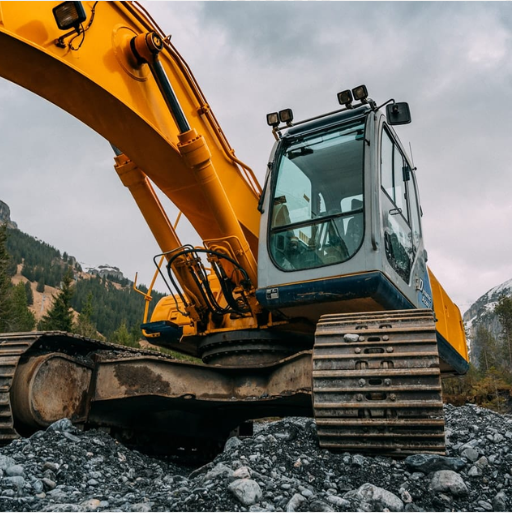
Materials for Bearing Rings and Rolling Elements
Bearing Rings Materials:
Steel:
Chrome Steel (AISI 52100): Common material for bearing rings due to its high strength, hardness, and wear resistance properties.
Stainless Steel: Offers corrosion resistance in harsh environments, making it suitable for applications where cleanliness and rust prevention are critical.
Carbon Steel: Economical choice for general-purpose bearings with moderate load and speed requirements.
Ceramics:
Silicon Nitride: Known for its high hardness, low density, and excellent thermal properties, making it suitable for high-speed and high-temperature applications.
Zirconia: Provides high strength, wear resistance, and electrical insulation properties, ideal for demanding operating conditions.
Plastics:
Polymer Composites: Offer lightweight, corrosion resistance, and self-lubricating properties, making them suitable for low-load, low-speed applications or where non-metallic materials are preferred.
Rolling Elements Materials:
Steel:
Chrome Steel (AISI 52100): Widely used for rolling elements due to its high hardness, wear resistance, and fatigue strength characteristics.
Stainless Steel: Provides corrosion resistance, suitable for applications where cleanliness and rust prevention are essential.
Ceramics:
Silicon Nitride, Zirconia: Ceramic rolling elements offer advantages such as high hardness, low friction, and resistance to wear and thermal expansion, beneficial for high-performance applications.
Hybrid Materials:
Ceramic Balls with Steel Races: Combines the benefits of ceramic (high hardness, low friction) with steel (high strength, toughness), offering improved performance and durability.
Factors Influencing Material Selection:
Operating Conditions: Consider factors like load, speed, temperature, and environmental conditions to choose materials that can withstand the specific demands of the application.
Lubrication: Compatibility with lubricants and ability to retain lubrication play a role in material selection for optimal performance.
Cost vs. Performance: Balance between material cost, performance requirements, and expected service life to achieve a cost-effective solution.
Application in Construction Equipment:
Bearings in construction equipment must withstand heavy loads, high speeds, shock loads, and environmental challenges. Selecting appropriate materials for bearing rings and rolling elements ensures reliable performance and extended service life.
Consideration of material properties, such as hardness, strength, wear resistance, and corrosion resistance, is crucial in improving equipment efficiency, reducing maintenance costs, and enhancing overall productivity.
By understanding the characteristics of different materials used for bearing rings and rolling elements, construction equipment manufacturers and maintenance teams can make informed decisions regarding material selection to optimize bearing performance and reliability in demanding operating conditions.
Brands of Bearings in Construction Equipment:
| Brand | Overview | Differentiation |
| SKF | A leading global supplier known for high-quality bearings designed to meet demanding construction requirements | Recognized for reliability, performance, and innovative technologies |
| NSK | Prominent manufacturer offering a comprehensive lineup of precision bearings for construction machinery | Acclaimed for precision, durability, and contribution to enhanced equipment efficiency |
| FAG | Renowned brand part of the Schaeffler Group, emphasizing robustness and load-carrying capacity | Stands out for robust engineering, performance in heavy-duty applications, and use of advanced technology |
| Timken | Well-established brand with a focus on durability and performance in rugged construction environments | Known for reliability, longevity, and ability to withstand high loads and harsh conditions |
| NTN | Trusted name providing a diverse range of precision bearings suitable for construction equipment applications | Excels in precision, efficiency, and consistent performance, meeting the unique demands of construction machinery |
| Schaeffler | Represents brands like INA and FAG, delivering quality bearings for construction equipment | Known for high load capacity, operational reliability, and optimization of construction machinery performance |
This table provides a concise overview of key bearing brands in the construction equipment sector, highlighting their respective strengths, differentiation factors, and areas of expertise within the industry.
Applications of Bearing Brands in the Construction Industry
SKF:
Concrete Mixers: SKF bearings are commonly used in concrete mixers for their reliability and ability to withstand heavy loads and vibrations.
Cranes and Hoists: SKF bearings support the smooth operation of cranes and hoists in construction sites, ensuring precise movement and load handling.
NSK:
Excavators: NSK bearings are preferred in excavators for their durability, precision, and resistance to contamination, essential for reliable performance in digging and loading tasks.
Tower Cranes: NSK bearings help facilitate the rotation and lifting mechanisms of tower cranes, ensuring stability and efficiency in vertical construction projects.
FAG:
Earthmoving Equipment: FAG bearings are utilized in earthmoving machinery for their robustness and load-carrying capacity, essential for handling tough terrains and heavy materials.
Piling Rigs: FAG bearings in piling rigs offer high precision and reliability during foundation construction, supporting the drilling and pile installation processes.
Timken:
Asphalt Pavers: Timken bearings play a crucial role in asphalt pavers, providing smooth operation and load support for laying asphalt surfaces with precision.
Crushers and Screens: Timken bearings in crushers and screens ensure efficient crushing and screening of construction materials, contributing to the production process.
NTN:
Road Rollers: NTN bearings are commonly found in road rollers for their precision and durability, helping achieve uniform compaction and smooth road surfaces.
Concrete Pump Trucks: NTN bearings support the pumping mechanisms in concrete trucks, ensuring consistent performance during concrete placement activities.
Schaeffler:
Bridge Construction: Schaeffler bearings are integral in bridge construction equipment, providing stability and load support for various structural elements.
Tunnel Boring Machines: Schaeffler bearings assist in the smooth operation of tunnel boring machines, ensuring precision and reliability in underground construction projects.
These specific applications demonstrate how each bearing brand plays a vital role in supporting the diverse equipment and machinery used in the construction industry, contributing to operational efficiency, reliability, and overall project success.
Interchangeability of Bearing Products Among Brands in the Construction Industry
When it comes to construction equipment, ensuring the reliability and longevity of bearings is paramount. The bearings used in construction equipment must withstand extreme conditions and heavy loads. Here are some of the top bearings available for construction equipment, known for their durability and high performance.
Bearing Types and Specifications
| Type | Bore Diameter | Outside Diameter | Width | Brand |
|---|---|---|---|---|
| GE120ES | 120 mm | 180 mm | 85 mm | SKF |
| GE80ES | 80 mm | 120 mm | 55 mm | SKF |
| GE60ES | 60 mm | 90 mm | 44 mm | SKF |
| GE50ES | 50 mm | 75 mm | 35 mm | SKF |
| GE30ES | 30 mm | 47 mm | 22 mm | SKF |
Interchangeability with Different Brands
In construction equipment, bearing interchangeability is crucial for maintenance efficiency and minimizing downtime. Here are a few notable interchangeable bearings:
- GE120ES: This SKF bearing can be interchanged with the NSK GE120ES model, which offers the same dimensions and load capacity.
- GE80ES: The GE80ES bearing is compatible with similar models from FAG and NTN, providing flexibility in sourcing.
- GE60ES: Known for its versatility, the GE60ES can be replaced with equivalent models from INA and Timken.
- GE50ES: This model has counterparts in brands like Koyo and Nachi, ensuring easy availability and compatibility.
- GE30ES: The GE30ES bearing is widely used and has interchangeable options from various manufacturers, including NTN and SKF.
UCTH213-40J-300 with Setscrew(inch)
CNSORDERNO: Normal-duty(2)
TOGN: UCTH213-40J-300
SDI: B-R1/8
SD: 2 1/2
UCTH212-39J-300 with Setscrew(inch)
CNSORDERNO: Normal-duty(2)
TOGN: UCTH212-39J-300
SDI: B-R1/8
SD: 2 7/16
UCTH212-38J-300 with Setscrew(inch)
CNSORDERNO: Normal-duty(2)
TOGN: UCTH212-38J-300
SDI: B-R1/8
SD: 2 3/8
UCTH212-36J-300 with Setscrew(inch)
CNSORDERNO: Normal-duty(2)
TOGN: UCTH212-36J-300
SDI: B-R1/8
SD: 2 1/4
UCTH211-35J-300 with Setscrew(inch)
CNSORDERNO: Normal-duty(2)
TOGN: UCTH211-35J-300
SDI: B-R1/8
SD: 2 3/16
UCTH211-34J-300 with Setscrew(inch)
CNSORDERNO: Normal-duty(2)
TOGN: UCTH211-34J-300
SDI: B-R1/8
SD: 2 1/8


















